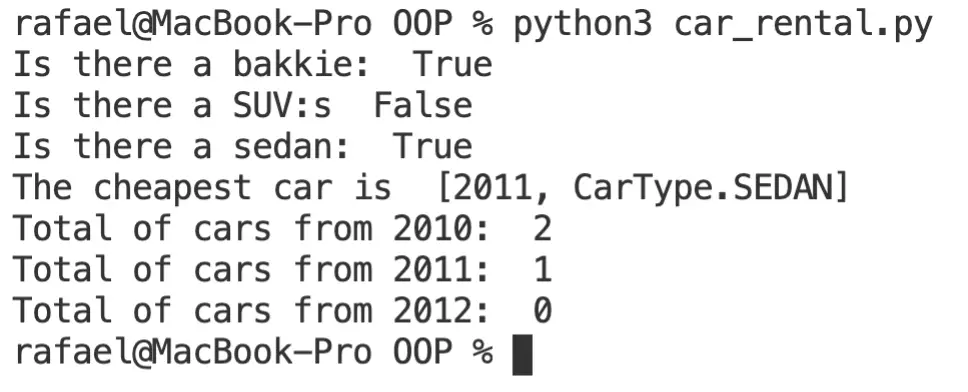Are you a beginner looking for an example of a program using OOP? In this article, I’ll show how to create a program using OOP in python to help a car rental company to automate its business.
The problem: Car Rental Company
Company X has a car rental service. The business knows for each of the 100 cars the following: year model, type of the car, the price per day and if the car uses petrol or diesel.
a) Identify the class (or classes) that models this situation using the Object-Oriented Paradigm.
b) Implement the identified class (or classes).
c) Implement the necessary methods to achieve the following:
i) Introduce new cars for rental.
ii) Answer if there is a specific type of car for rental given the type of car.
iii) Know the cheapest car in the company.
iv) Know how many cars of a specific year are available for rent.
Solving the problem using OOP
The first step is usually to create a UML diagram. Because this example is very simple, I won’t create the UML diagram, but I encourage you to create it.
UML diagrams are important to have a general understanding of the software.
In our problem, we have two classes: one to represent the company and the other one to represent cars.
Class Car in Python
To implement the class car, we are going to create two extra classes: CarType and Fuel.
According to the problem description, the cars have a type and can only be of three types. That is a good indication that we have to use an enum. This “special type of classes” only defines the values that can be assigned.
The fuel type is similar. We can have a car that uses diesel or petrol. That’s another good opportunity to use enums.
from enum import Enum
class CarType(Enum):
SEDAN = 1
SUV = 2
BAKKIE = 3
class Fuel(Enum):
DIESEL = 1
PETROL = 2
class Car:
def __init__(self, model_year, type, price_per_day, fuel):
self.__model_year = model_year
self.__type = type
self.__price_per_day = price_per_day
self.__fuel = fuel
def get_type(self):
return self.__type
def get_price_per_day(self):
return self.__price_per_day
def get_model_year(self):
return self.__model_year
def __str__(self):
return '['+self.__model_year + ', ' + str(self.__type)+']'Class Company in python
In this case, the methods that we have to implement should be in the class company. One way to notice that all the methods must be implemented in the class Company is to ask ourselves what data we need to implement the methods.
For instance, to answer the question “is there a specific type of car for rental given the type of car?”, we need to check all the cars the company have.
Where are all the cars stored?
They are in the class Company. So we have to implement this method in the class Company. You can use similar thinking with the rest of the questions.
class CompanyX:
def __init__(self):
self.cars = []
def add_car(self, car):
self.cars.append(car)
def is_there_a_specific_type_of_car(self, type):
for car in self.cars:
if car.get_type() == type:
return True
return False
def cheapest_car(self) -> Car:
cheapest = self.cars[0]
for i in range(1,len(self.cars)):
if self.cars[i].get_price_per_day()<cheapest.get_price_per_day():
cheapest = self.cars[i]
return cheapest
def how_many_car_from_specific_year_are_available(self, year):
counter = 0
for car in self.cars:
if car.get_model_year()==year:
counter += 1
return counterBasic algorithms used in the previous implementation
- is_there_a_specific_type_of_car: In this method a simple search was used. We iterated over all the elements of the collection or array, when we found the type of car we were looking for, we return a result.
- cheapest_car: A basic algorithm for finding a minimum. In this case, we assume the first element of the collection is the minimum (the cheapest car in this case), then we go through the rest of the elements of the collection, and if we find a car that is cheaper than the one we assumed is the cheapest one, we update the cheapest car.
- how_many_car_from_specific_year_are_available: A basic algorithm for counting. We iterate over the elements of the array. If the current car has the same year model as the parameter of the method, we count.
To check the general form of the counting basic algorithm, you can read this article.
Executing our code in python
Now is time to create a console app so we can put our code to work.
First, we create an object of type CompanyX. This object will represent the company and, it will be the entry point to our code.
Then we create three cars (it can be more) and add them to the company using the corresponding method.
Now we can use the other methods we implemented.
The company has three cars. It is time to use the methods we implemented:
- if there is a car of a certain type
- what is the cheapest car (according to the rental price)
- the total of cars that have a specific year model.
if __name__ == '__main__':
company = CompanyX()
car1 = Car('2010', CarType.SEDAN, 25.0, Fuel.DIESEL)
car2 = Car('2011', CarType.SEDAN, 22.0, Fuel.PETROL)
car3 = Car('2010', CarType.BAKKIE, 35.0, Fuel.DIESEL)
company.add_car(car1)
company.add_car(car2)
company.add_car(car3)
print ('Is there a bakkie: ', company.is_there_a_specific_type_of_car(CarType.BAKKIE))
print ('Is there a SUV: ', company.is_there_a_specific_type_of_car(CarType.SUV))
print ('Is there a sedan: ', company.is_there_a_specific_type_of_car(CarType.SEDAN))
print ('The cheapest car is ', company.cheapest_car())
print ('Total of cars from 2010: ', company.how_many_car_from_specific_year_are_available('2010'))
print ('Total of cars from 2011: ', company.how_many_car_from_specific_year_are_available('2011'))
print ('Total of cars from 2012: ', company.how_many_car_from_specific_year_are_available('2012'))See the sample of output for this code below.

You can find the code in only one file here.
Feel free to add more functionality to this code so you can practice your skills. Think that you are the owner of the company. Then decide what new functionalities will be useful for you as the owner. After that, you can extend the code to support the new functionalities.
H@appy coding!
